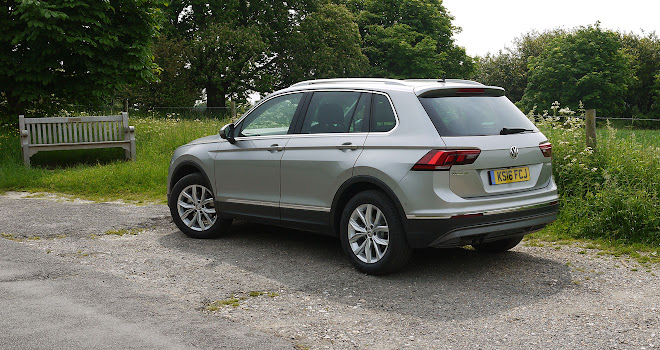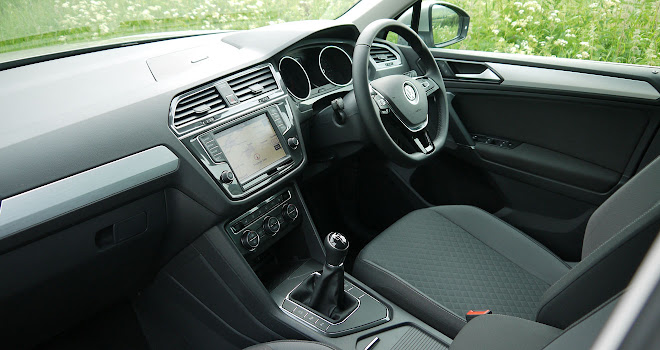
Rating: stars
Good: spacious, comfortable, 4x4 surprisingly capable off-road
Bad: expensive, not especially frugal
Price: from £22,510
I was going to describe the new Volkswagen Tiguan as a softroader, but that was before I inched over a blind crest of mud and surveyed the vertiginous descent beyond. A slippery, leaf-strewn hillside as steep as a staircase, dotted with very solid looking trees. I pause long enough to hope that this 4x4 VW is actually a proper off-roader. I also have time to wonder if the 19-inch road tyres were such a good idea, and if they’re about to become four rubber skis.
Fortunately, plummeting is the opposite of what happens. With off-road mode engaged and a prod of brake as we clear the crest, then both feet off the pedals, the Tiguan picks its way down the treacherous slope as I steer carefully around the timber. Clearly this is not a softroader – it has trousers to match its mouth.

VW’s hill descent assist system, while not as clever as a modern Land Rover’s, works well enough. It lets the car roll for a moment, then reins it in again using computerised dabs of brake at each corner, finding purchase where it can. The result is that the Tiguan inches its way to the bottom slowly and safely, if not entirely smoothly. The brakes groan a lot on the way down but there’s not a squeak from the chassis or so much as a rattle from the trim.
In short, the Tiguan seems remarkably at home romping through the forest and gambolling along boggy tracks, particularly for a car I’d pigeonholed as more inclined to double park outside the school gates.

VW says it expects 75% of new Tiguans to be ordered with 4Motion all-wheel-drive capability. That’s far above average for a car of this size and shape. Most urban off-roaders never go off road and make do perfectly well with front wheel drive.
For those who do intend testing the Tiguan’s mettle, it’s best to opt for the £350 Outdoor pack, which adds extra bash protection to the underside and a chinless front bumper to improve the car’s ability to approach obstacles without clouting its face. All 4Motion editions of the Tiguan also come with ride height of 200mm, 11mm higher than standard.
Upper spec cars feature a fully digital instrument panel, which will helpfully display steering angle when set to off-road mode. It’s easy to lose track of which way the wheels are pointing on a very slippery surface, so this can be a big help. Surround-view cameras are also a boon when trying to align the car to avoid off-road obstacles.

That’s the blue car in the photos above. The silver car below, meanwhile, would probably still be stuck in the mud if it tried the same tricks. It’s a front-wheel drive 2.0 diesel with a six-speed manual gearbox, in middle-of-the-range SE-Nav trim – likely to be a popular choice.
It exemplifies the other side of the Tiguan’s character, that of a refined and comfortable family car.

The Tiguan’s interior offers a typical blend of Volkswagen attributes: solid, sober and sombre. There’s lots of charcoal grey enlivened by bright metallic details, but I do find myself hankering for something that doesn’t look as if it has been transplanted straight from a Golf or Passat.
The countrified Fiat Panda 4x4, for example, seems to take inspiration from green wellies, wet dogs and waxed cotton jackets. The Tiguan’s mood board, by contrast, must have contained neatly polished shoes, a comb and a briefcase.

Under its skin the Tiguan shares much with the Golf, Passat and Touran. All four models are built on the same modular platform, albeit with suitable stretches in length and width. There’s also a strong family resemblance in the Tiguan’s crisp and restrained exterior styling. It’s very clearly part of the same clan, with none of the muscular bulges that Nissan added to its second-generation Qashqai, for example.
The closest the Tiguan gets to hinting at power is the way the sharp crease beneath the door handles fades away as it crosses the rear haunch. That’s pretty subtle.

Parked next to the old Tiguan, the new car looks more solidly proportioned, with more metal and less glass when viewed from the side. It’s longer, lower and wider than the car it replaces too. Children in the back row might prefer the deeper glazing of the old model, however.
Passengers will have nothing to complain about in terms of interior space. There’s ample room for heads, knees and elbows. There are numerous places to stow odds and ends, including a flock-lined cubby on top of the dashboard with a lid that seems unusually flimsy for a piece of Volkswagen.

There’s no seven-seat option for the moment – a stretched edition is presumably on the way – meaning a generous boot with enough room for a spare wheel under the floor. The split rear seats can slide independently backwards and forwards, moving 2cm more than in the outgoing Tiguan, to trade luggage space for legroom
On the move, there’s no mistaking that you’re riding in a tall car, even in the front-wheel-drive version. There’s a lot more body movement over bumps than you’d get in a Passat, though the upside is a gentle ride where the shocks of broken tarmac are tidied away with barely a murmur.

VW’s 2.0-litre diesel engine feels capable and sounds throaty when pushed. Either the 2WD or 4WD car can reach 62mph in 9.3 seconds. At low revs when cruising, the engine murmurs gently and unobtrusively, especially if you follow the gearshift hints on the central instrument panel. These keep telling me I’m in the wrong gear. Ignore the hints for long enough and the screen between the clocks will flash up a scolding reminder to take note. It also reprimands me for touching the throttle on startup, a fuel-wasting habit from the days of carburettors, chokes and wondering whether the engine will oblige.
CO2 ratings for the 150-horsepower diesel start at 125g/km for the 2WD model rising to 141g/km for the 4Motion variants. Opting for a 7-speed dual-clutch automatic over the 6-speed manual raises the tally to 129g/km and 149g/km respectively. A lower-powered 115bhp diesel comes in at 123g/km, in base S-level trim and with manual gears only. There is also a 150bhp 1.4-litre petrol option rated at 132g/km.

Later this year a plug-in hybrid GTE edition of the Tiguan will arrive, expected to use much the same setup as the Passat GTE. It will pair a petrol engine with an electric motor, both driving through a twin-clutch automatic gearbox to allow either two- or four-wheel-drive. The combination should provide upwards of 200bhp and a sub-50g/km CO2 rating.
Within the current line-up, prices start at £22,510 for the entry level petrol edition. The model VW expects to be the best seller – in SE-Nav trim with 150bhp diesel, manual gears and four-wheel-drive – costs from £29,745.
As ever with VW products, the new Tiguan offers quality and capability, but few would accuse it of being cheap.




